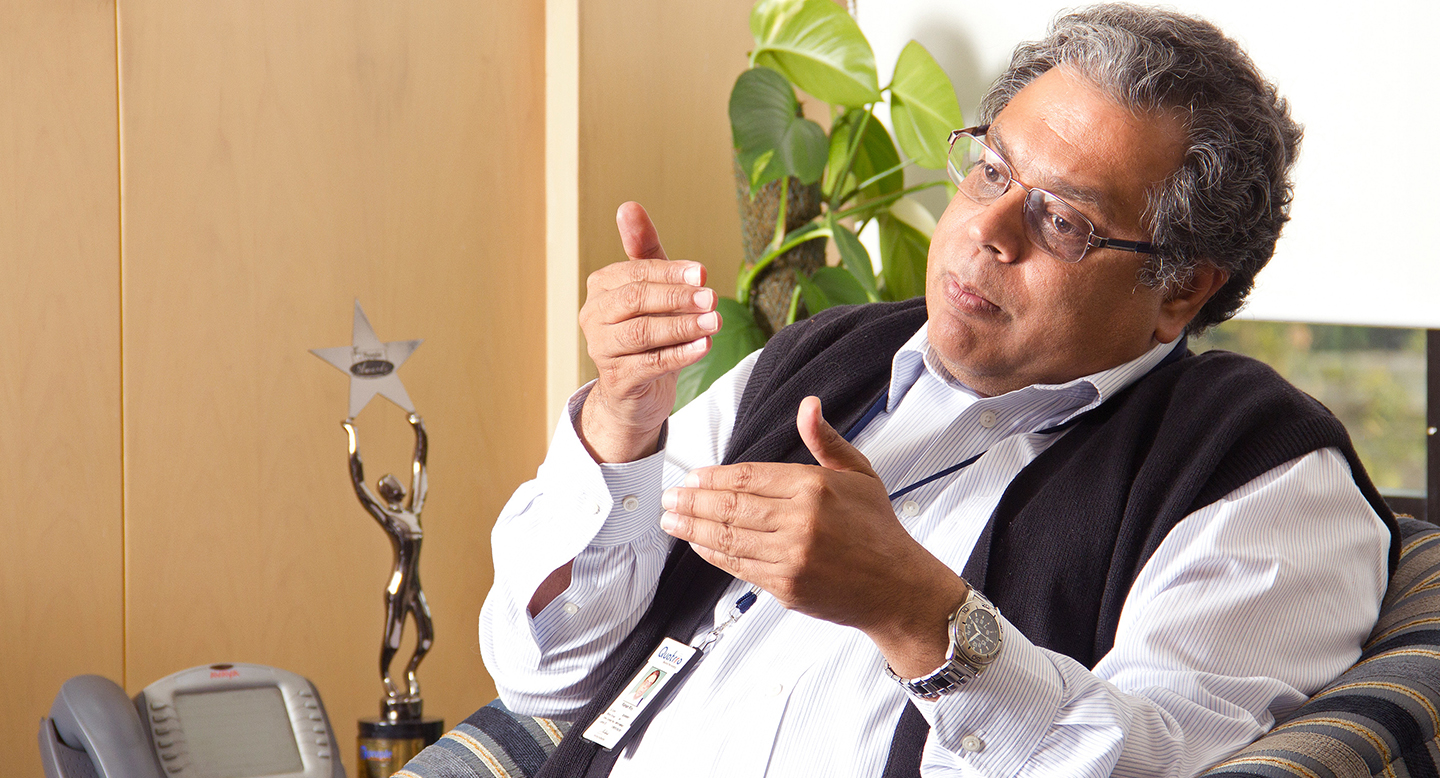Raman Roy, chairman and MD, Quatrro Global Services, narrates 10 stories from his journey at the helm of India’s BPO industry

In a 2007 article in Forbes.com, the magazine’s senior correspondent, Ruth David, called Raman Roy the father of Indian outsourcing. She had her reasons for this grand statement. After all, Roy is credited with several firsts in the offshoring business – he setup and grew one of the first ever offshoring facilities for a global company (Roy setup American Express’ back-office in India), was responsible for pioneering the process for voice business process outsourcing (BPO) operations (for General Electric) and overall, has been recognised as the captain of India’s BPO sector for over two decades now.
Roy’s contribution to the country is immense for one simple reason – the BPO and ITeS industry has led the creation of jobs in India.
In FY2012, according to a NASSCOM report, the aggregate revenue from the IT-BPO industry was over US $100 billion, 23 per cent of which came from the BPO segment. Roy did receive early recognition for his contributions. In 2002, Dataquest magazine awarded him with the Pathbreaker Award for directly creating over 35,000 jobs (at that time; he has created several more since then) in India. Over the last two decades, Roy has sworn by two words – process and people – key attributes to any successful BPO operation.
After his professional stints at American Express and General Electric, Roy decided to turn entrepreneur by launching Spectramind, one of the first third-party BPO services companies in the country. He then exited Spectramind by selling it to Wipro and founded Quatrro, to offer BPO and KPO services to small and mid-size companies around the globe.
In this chat with The Smart CEO, Roy shares with us 10 short stories from his entrepreneurial life and the lessons he learnt from each of these experiences.
In the early days of Spectramind, convincing the spouse was an integral part of our hiring process. I still remember a box of laddus that one of our core team member’s wife presented to me after we exited Spectramind.
The day I sold Spectramind The day we closed the deal with Wipro to sell Spectramind is very close to my heart. I still remember how the deal was finally done at 2 a.m. in the morning and I was sending vehicles to bring my core team back into work to be with the rest of us on this special day.
The focus of our conversation that day was why we had to sell and why Wipro was a good suitor. As any entrepreneur who has sold a company will tell you, it feels like you are giving away your daughter. We decided to sell because the BPO industry was going through a transition. The business was cash hungry and we could not keep going back to the VC world to raise money. Wipro understood the people, understood our business and we were very happy to sell to them.
It was a day when over 600 shareholders made money and it was a day to remember. For me, it was exciting, simply because I kept my promises – of creating wealth for my people, value for our customers and very good returns for our investors.
Hiring the spouse
Let me narrate a story from the early days of Spectramind. I had quit GE and was ready to launch a third-party BPO services company. During the hiring process, there was one thing I always had to do – convince the spouse! It was an integral part of my hiring process. I distinctly remember one person who came on board and then quit because his wife didn’t want him to leave his ‘large company’ job.
Those days, it was difficult to define what exactly we were doing to the external world – I was transparent the whole time, acknowledging that this business might not work. But, on the other hand, I always used to tell people this was their chance to work on something game changing. After the Spectramind sale, one of the wives came to me with a box of laddus and said, “I wasn’t convinced about my husband’s move back then. Today, I know all the effort was worth it.”
I would say the biggest challenge for us was that we could not benchmark ourselves to any particular company to our prospective hires. What we were trying to do was fairly new and most BPOs at the time dealt with this challenge. Over time, we did a really good job of communicating what we did and Spectramind became the benchmark.

Board Conversations
Over the years, I have been a part of board meetings of various genres. At American Express, the early board meetings revolved around keeping the back-office company separate from the American Express bank mainly because the bank had a very strong union. At General Electric, board meetings were often mere formalities because our strategic roadmap was fairly clear. These days, at Quatrro, a large part of our time spent in board meetings revolves around mergers, acquisitions and potential deals.
Let me narrate a story from a marquee board meeting we had at Spectramind. Ashish Dhawan and Raj Kondur of ChrysCapital, our investors, were part of our board. The meeting I am referring to was to decide whether we could do technical support for companies like Dell and HP from India. At the time, no one had attempted something like that and we were evaluating the opportunity. The typical questions were asked – how big is the market? Will global technology players outsource to India? Do we have the ability to hire talent in an area where the IT services industry grabs the best talent available? I remember this meeting because we decided to go ahead and do it and also discussed the operational strategies. Very soon, we won Dell as a customer and over time clinched HP, Cisco, Microsoft and Bell South as customers. We had 9,000 people working on tech support from India. The decisions we made at that board meeting ended up making a huge difference to Spectramind.
A story on what not to do As soon as we setup Spectramind, we clinched a client who wanted to outsource some high-end work into India. He wanted us to hire PhDs in molecular biology to work on some aspect of the human genome project. To me, with my background of serving American Express and General Electric, it was fascinating yet new to serve a client in this area.
In any case, even before our office was ready, we setup interviews at Surya Sofitel and invited over 30 people – all PhDs in molecular biology to come in for interviews. We had finished the HR round and people were flown in to meet directly with the client. In the briefing, before the client could start meeting the candidates, we suddenly realised we made a huge blunder. There were two kinds of molecular biologists – those who worked on the human side and those who worked on the agriculture side. Our client wanted only people with expertise on the human side of molecular biology. As luck would have it, out of the 30 odd people, only five fit the bill. I had to go talk to the other candidates saying we had made a mistake and that we could not interview them. Money was wasted and it was embarrassing for us. It was a huge lesson for us not to jump to conclusions and study any requirement in great depth before starting the process of interviewing people. Finally, we did win the project, but the lesson learnt will never leave my memory.
On acquisitions
In a services environment, jumping to conclusions on potential acquisitions simply based on capability or skill needs is a bad idea. The most important aspect of any merger or acquisition is that the leadership teams of the two companies have to get along. They should understand each other’s goals and needs. In the case of Scope e-knowledge, a company we acquired, we understood each other’s ambitions very clearly.
These days, I look at India Angel Network from a very different perspective. I go meet some entrepreneurs, I come back energised. The realisation is that it is not a one-way street. It never was. The mentors and investors get as much out of the experience as the early-stage entrepreneur gets. After every IAN meeting, I come back bursting with ideas.
![]()
In another scenario, where we acquired a foreign company, things didn’t go as per plan. The mistake we made was that we didn’t analyse if their leadership team was in true agreement with our game plan or whether they were just offering lip service.
At Quatrro, we’ve now made the call that we’ll never go in with a minority stake in the case of acquisitions. Having said this, once you have to look at your ownership, it shows the relationship has degenerated. At the end of the day, the people on both sides have to get along.
Crossing the chasm, step-by-step
While we were pitching (an internal pitch to the global organisation) for setting up the offshoring facility for American Express, I still remember with clarity, the many different discussions we had. One member of the global team who was skeptical about outsourcing to India pointed out that, just to talk on the phone from India to the U.S., we had to book a lighting call. Those days, we could not just pick up the phone and call the U.S.
The question he asked us – and it was very valid – was, with such an environment and low quality of information and communication infrastructure, how could we expect to deliver work out of India? I explained to him that we were not planning to use the government-controlled infrastructure, but an alternative option that worked. I went on to explain – in detail – the alternative private IT infrastructure we had.
Like the question on infrastructure, there were many different questions that were asked. There were believers and there were non-believers. Eventually, we converted some of the non-believers into believers. How did we do it? By addressing their concerns, one-by-one, with a lot of clarity. Once you figure out the operations of a particular process, the second crucial aspect is to convince the client about why that particular process will work. We crossed the chasm, one step at a time.
B2C offshoring
At Quatrro, in addition to our 17,000 odd customers, we service about 0.5 million individual customers who pay us to handle tech support. When we built Spectramind, the focus was on serving large customers. Then, as we started Quatrro, the idea was that we could build a business model around serving the mid-market, essentially small and medium-sized companies in the West. But, all of a sudden, we thought about something that happened in our Spectramind days. We used to serve under-warranty customers of companies like HP and took care of solving their computer-related problems. For this, the client paid us US $12.50 per customer. However, if he or she was out of warranty, then we could not service him/her and the customer would get it serviced locally at a price of over US $100.
As we discussed this story and analysed the spending of the out-of-warranty customer, we thought we could get into a B2C play to service these customers at a much lower price. We could charge him US $12.50, make a margin of 15 to 20 per cent per customer and still help him save a ton of money. We decided to get into serving individual customers, yet another “new process” we wanted to tackle. The operational processes needed to implement this were vastly different from working for a corporate client, but we made it happen and today, we serve over half a million individual customers at Quatrro.

The mid-market difference
In my earlier stints, I had never clinched a project before a client visited our facility. So once I started Quatrro, I requested one of my early clients, a senior professional from a small company, to come visit and he said, “No way, I cannot spend money and come all the way to India.” Over time, we realised that at Quatrro we would hardly have clients visiting us because of our focus on the mid-market. I would say, out of the 17,000 customers we have, only 1 per cent have visited our facilities.
This is an example of why our operational strategy at Quatrro has to be completely different from what it was at Spectramind. For starters, we have to be able to convince a client of our capabilities without them visiting us. We have to give them the facility to kick the tires and look under the hood, without visiting us.
There are several other differences as well. While serving a large company, we used to work on the client’s technology platform. Nowadays, we train our mid-market client on our technology platform. Also, we have a lot of people who work on multiple clients or projects simultaneously. In the mid-market, receivable management is also crucial. I have had the experience of one of our clients talking to me on Friday morning about establishing a new process out of India and next week, the company filed for bankruptcy. In large companies, payment may get delayed, but payments come and so we continue servicing, in the mid-market that does not always work.
Over the last few years at Quatrro, we have had an eye opening experience – the small and mid-size client is a totally different type of customer, so we need a specialised strategy to tackle this market. I believe, with Quatrro, we have laid the foundation of being a specialised outsourcing service provider for the mid-market and are now gearing up to penetrate further into the market, clinch more small businesses as customers and cross-sell our multiple offerings to them.
The lesson here is that even if you believe you understand a particular business or sector, be prepared for a whole new experience.
When we got ahead of ourselves
Our industry is called the IT-enabled services industry for a reason – we adopt the latest technologies in our operations. We do real-time work for a client so many miles away – the technology plays the role of making distances go away!
In our captive days, everyone used to talk of Voice-over-IP (VoIP) being the next big thing. So when we setup Spectramind, we decided to layout our floor cabling suited for VoIP. One whole floor was laid out and then suddenly, we realised that the technology was not really ready to use in a KPO operation. Recording could not happen and there were several other challenges in terms of call quality. We had to re-lay the whole cabling, move to traditional technology and the whole thing cost over US $100,000. The experience, to say the least, was sobering. This also delayed the project start dates. I would say, yet again, that it is important to dig deep before making such expensive calls. Today, VoIP technology is stable and reliable and we use it everywhere. But back then, it was too early.

My energy shot
The India Angel Network was formed over a drink while about five of us were chatting. The conversation was about how people come meet us through a personal contact, we give him or her some advice and then, we have no idea what happens to his/her venture. The idea was that mentorship plus money could do something useful, so the five of us got together and founded the India Angel Network (IAN).
However, today, I look at IAN from a very different perspective. I go meet some entrepreneurs, I come back energised. The realisation is that it is not a one-way street. It never was. The mentors and investors get as much out of the experience as the early-stage entrepreneur gets. After every IAN meeting, I come back bursting with ideas.
Raman Roy, a profile
Roy is popularly referred to as the father of the Indian BPO industry, having helped both American Express and GE setup back-office operations in India. Then, in the year 2000, Roy
went on to start Spectramind, a third-party services BPO/KPO that eventually sold out to Wipro. Today, he runs Quatrro Global Services, a BPO/KPO that serves the mid-market and individuals across the world.
The company currently serves over 17,000 mid-market corporate customers and over 0.5 million individual customers worldwide. Roy has adopted a mix of organic and inorganic growth strategies to grow Quatrro and confesses that the biggest challenge facing the Indian BPO industry is lack of talent availability. On the future of the Indian BPO industry, Roy believes that companies will now look at quality of services offered more than ever, in addition to the cost advantages of offshoring.
From a personal leadership standpoint, Roy says, over his last four corporate avatars, he’s realised the importance of hard work. He says, “Young entrepreneurs must realize that success doesn’t come overnight, it comes from years and years of hard work. There is just no replacement to working hard and I cannot emphasize this more.”
The most difficult problem at any startup
“You could be working on solving an extremely critical problem for a large market. You could work on the cutting edge of technology, grapple with operational challenges and adopt smart strategies to hire the best people.
What ever you may be doing at your startup, the most difficult problem that you want to avoid is having no money to pay your salaries. Have we been there? Yes. A customer could not pay on time and we were short of a few lakh rupees to pay out our salaries. What are your options then?
You could talk to your bank for some extra limit. You could, somehow, get your customer to pay up. Or, maybe, you might have to go talk to your senior managers and tell them that you would pay their salaries late, but will pay everybody else.
It is always very easy on Excel sheets, in reality, these things do happen and it is a humbling experience. For entrepreneurs who are dealing with a similar crisis, it is important to know that other people have been there and dealt with it. You can too.”





